1. About this Guide
- For information on FLEXlm* and FlexNet* software created by Flexera* Software, see https://www.revenera.com/.
- For information on Intel® Software Development Products, see http://developer.intel.com/software/products.
- For more information about Intel® Software Development Product licenses and their usage, see /content/www/us/en/developer/get-help/faq-licensing.html.
2. About the Intel® Software License Manager
2.1 Current Version
The current version of Intel Software License Manager available for download is 2.10.0. This uses Flexera Flexlm version 11.16.4.
NOTE: The 2020 release of Intel Parallel Studio and its components require the license server manager to be at Flexlm version 11.16.4 or higher. The 2019 release of Intel Parallel Studio and its components require the license server manager to be at Flexlm version 11.15.1 or higher. The 2018 release of Intel Parallel Studio and its components require the license server manager to be at Flexlm version 11.14.1 or higher.
2.2 Supported Platforms
- Microsoft Windows* for IA-32 and Intel® 64 architectures
- Linux* IA-32 and Intel® 64 LSB (Linux Standards Based) compliant architectures
2.2 Floating License
SERVER licserver 00270e00ffff 27009 VENDOR INTEL PACKAGE IF83F2F10 INTEL 2018.0515 E4AB5E0CA283 COMPONENTS="AdvXEl \ ArBBL CCompL Comp-CL Comp-FL Comp-OpenMP Comp-PointerChecker \ DAAL-L DbgL FCompL MKernL PerfAnl PerfPrimL StaticAnlL \ ThreadAnlGui ThreadBB" OPTIONS=SUITE ck=147 SIGN=BC6DBB4847FA INCREMENT IF83F2F10 INTEL 2018.0515 permanent 2 73866154322D \ VENDOR_STRING="SUPPORT=COM \ https://lemcenter.intel.com" HOSTID=ANY \ PLATFORMS="i86_r i86_re it64_lr it64_re amd64_re i86_mac \ x64_mac" BORROW=169 DUP_GROUP=UH ck=108 SN=SMSA6W6KC6M5 \ SIGN=1E20119EACBA
- Host name: licserver. It must contain the host name returned by the OS.
- Host id (lmhostid): 00270e00ffff
- Port Number: 27009. This the port used by lmgrd.
- Vendor: INTEL. This is the name of the vendor daemon to use. To specify the port used by the INTEL daemon, specify it on this line with: port=28519. Otherwise it will use a port assigned by the OS.
- Supported Software Products: AdvXEl (Intel® Advisor for Linux*), Comp-CL (Intel® C++ Compiler for Linux*), Comp-FL (Intel® Fortran Compiler for Linux*), etc.
- Older license files may not have feature codes used by newer product versions.
- Supported Product Platforms: i86_r, i86_re (Linux* on IA-32 architecture), it64_lr, it64_re (Linux* on IA-64 architecture), i86_mac (Intel®-based systems running OS X*)
- This is the platform running the product, and does not restrict the platform used for the license manager.
- Intel Support Expiration Date: 2018.0515 (May 15, 2018)
- The support expiration applies to access to product updates and support. Products built after the support expiration date are not supported by the license.
- Product Expiration Date: permanent (Never expires)
- The license will always support products built before the support expiration date, even if the support expiration date has passed.
- License Count: 2.
- Two licenses can be checked out simultaneously.
2.3 Technical Support
2.4 Client/Server Backward Compatibility
3. Registration and Downloads
3.1 License Registration
3.2 Intel® Software License Manager downloads
4. License Activation and Configuration
4.1 Activation
4.1.1 Host Name and Host ID
4.1.1.1 Microsoft Windows*
- From the Start menu, click Run...
- Type cmd in the Open: field, then click OK.
- Type ipconfig /all at the command prompt, and press Enter.
Host Name . . . . . . . : mycomputer . . . Physical Address . . . . : 00-06-29-CF-74-AA
4.1.1.2 Linux*
- Run the hostname command to display the host name. If the fully qualified domain name is shown, then the license file must use it.
- Run the command /sbin/ifconfig eth0 to display the hardware address.
For example, if the /sbin/ifconfig eth0 command returns
HWaddr 00:D0:B7:A8:80:AA
then the host ID is 00D0B7A880AA.
4.2 Configuration
4.2.1 Ports
- The port numbers in all license files match on both the license host server and client systems.
- The license server is restarted to read the updates.
- The INTEL_LICENSE_FILE environment variable on the client systems is pointing to the correctly updated license file or port@host.
4.2.1.1 lmgrd
SERVER licserver 00270e00ffff 27009
4.2.1.2 INTEL daemon
VENDOR INTEL port=<port>
- In Windows*, this is typically located at C:\Program Files\Intel\licenseserver\Iflexlm.log
- In Linux* and Mac OS*, this is typically located at /opt/intel/licenseserver/lmgrd.log
14:16:16 (INTEL) (@INTEL-SLOG@) =============================================== 14:16:16 (INTEL) (@INTEL-SLOG@) === Vendor Daemon === 14:16:16 (INTEL) (@INTEL-SLOG@) Vendor daemon: INTEL 14:16:16 (INTEL) (@INTEL-SLOG@) Start-Date: Tue Oct 03 2017 14:16:16 Pacific Daylight Time 14:16:16 (INTEL) (@INTEL-SLOG@) PID: 23500 14:16:16 (INTEL) (@INTEL-SLOG@) VD Version: v11.14.1.1 build 201886 x64_n6 ( build 201886 (ipv6)) 14:16:16 (INTEL) (@INTEL-SLOG@) 14:16:16 (INTEL) (@INTEL-SLOG@) === Startup/Restart Info === 14:16:16 (INTEL) (@INTEL-SLOG@) Options file used: None 14:16:16 (INTEL) (@INTEL-SLOG@) Is vendor daemon a CVD: No 14:16:16 (INTEL) (@INTEL-SLOG@) Is TS accessed: No 14:16:16 (INTEL) (@INTEL-SLOG@) TS accessed for feature load: -NA- 14:16:16 (INTEL) (@INTEL-SLOG@) Number of VD restarts since LS startup: 0 14:16:16 (INTEL) (@INTEL-SLOG@) 14:16:16 (INTEL) (@INTEL-SLOG@) === Network Info === 14:16:16 (INTEL) (@INTEL-SLOG@) Listening port: 55294 14:16:16 (INTEL) (@INTEL-SLOG@) Daemon select timeout (in seconds): 1
4.2.2 Redundant Server Setup
- Identify the three servers you will use to run the license manager.
- Go to the Intel Registration Center and open the license file for modification.
- Check the box to enable the three server configuration.
- Enter the host ID and host name for each server. These IDs and names must be unique.
- Submit the changes and download the updated server license file.
- Download and install the latest Intel® Software License Manager package on each server named in the license file.
- Ensure that all three servers are running the license manager to establish a quorum.
- Install or run the licensed product on a client machine as you would for a single server configuration. The license file used by the client must contain all three server names above the VENDOR line.
4.2.3 License Borrowing
5. Installing the Intel® Software License Manager
5.1 Windows* Installation
- Download the latest Intel® Software License Manager for Windows* that matches your environment (w_isl_server_<ver>.exe).
- Run the self-extracting executable downloaded in the previous step.
- Accept the license agreement to continue with the installation.
- To configure the license manager, you must provide a serial number or license file:

- To use a serial number, you must be connected to the internet.
- If you have already activated your license, select the same host ID you provided to the registration center. This will generate the license file in a default folder used by the license manager.
- If you have not activated your license, select either host ID. This will automatically activate your license with the server’s host name and host ID you selected, along with default port values for the license manager daemons.
- To use a license file, browse to the location of your activated license file.
- The license manager installer uses C:\Program Files (x86)\Common Files\Intel\ServerLicenses as the default license folder. It will automatically detect licenses in that location. You can also set environment variable LM_LICENSE_FILE to point to a folder or license file.
- To use a serial number, you must be connected to the internet.
- If there are any invalid license files in the default license folder or LM_LICENSE_FILE, be sure to remove them.
- Finish the installation process. The license manager is installed in C:\Program Files\Intel\licenseserver and should start automatically as a service. It will create a log file named Iflexlm.log in the install folder.
- The Intel® Software License Manager service runs as the Local Service account. This may have insufficient privileges to create the log file in step 6, resulting in the license manager being unable to start. In this case, it is necessary to either change the Intel® Software License Manager service Log On account to Local System, or change the log file path to a folder writeable by the user account. See this article for more details.
- Ensure that the ports used by the license manager services are not blocked. There are two:
- Lmgrd port – this is specified in the license file and has a default value of 27009.
- INTEL port – this may be specified in the license file as: VENDOR INTEL port=<port>. As of December 2017, this is defaulted to 28519 in the Intel Registration Center. If it is not, then the OS will assign it when the license manager is started or restarted. Check the log file for the value.
5.2 Linux* Installation
- Place the downloaded package <l|m>_isl_server_<ver>_<architecture>.tar.gz in the directory to which you wish to extract its files. This need not be the same location in which you plan to install the Intel® Software License Manager files.
- Extract the files from the package with the following command:
tar -zxvf <l|m>_isl_server_<ver>_<architecture>.tar.gz
- Run one of the following scripts from the directory created to begin installation:
- install.sh – command line
- install_GUI.sh – graphical interface
5.2.1 Command Line Installation
- Select the elevation mode for the installation.
- Accept the license agreement to continue with the installation.
- To configure the license manager, you must provide a serial number or license file:

- To use a serial number, you must be connected to the internet.
- If you have already activated your license, select the same host ID that you provided to the registration center. This will generate the license file in a default folder used by the license manager.
- If you have not activated your license, select a host ID. This will automatically activate your license with the server’s host name and host ID you selected, along with default port values for the license manager daemons.
- To use a license file, enter the name and path of your activated license file.
- The license manager uses /opt/intel/serverlicenses as the default license folder. It will automatically detect licenses in that location. You can also set environment variable LM_LICENSE_FILE to point to a folder or license file.
- To use a serial number, you must be connected to the internet.
- If there are any invalid license files in the default license folder or LM_LICENSE_FILE, be sure to remove them.
- Start the installation. The default install location is /opt/intel/licenseserver. To change it:
- Select the Customize installation option:

- Select the Change installation directory option:

- Select the Customize installation option:
- Finish the installation process. The license manager should start automatically as a service with default options. To restrict access to license manager utilities, see the options listed under section 6.2.1 Start the license manager (lmgrd).
5.2.2 Graphical Installation
- Select the elevation mode for the installation.
- Accept the license agreement to continue with the installation.
- To configure the license manager, you must provide a serial number or license file:

- To use a serial number, you must be connected to the internet.
- If you have already activated your license, select the same host ID that you provided to the registration center. This will generate the license file in a default folder used by the license manager.
- If you have not activated your license, select a host ID. This will automatically activate your license with the server’s host name and host ID you selected, along with default port values for the license manager daemons.
- To use a license file, browse to the location of your activated license file.
- The license manager uses /opt/intel/serverlicenses as the default license folder. It will automatically detect licenses in that location. You can also set environment variable LM_LICENSE_FILE to point to a folder or license file.
- To use a serial number, you must be connected to the internet.
- If there are any invalid license files in the default license folder or LM_LICENSE_FILE, be sure to remove them.
- Start the installation. The default install location is /opt/intel/licenseserver. To change it:
- Click the Customize button:

- Change the Destination folder:

- Click the Customize button:
- Finish the installation process. The license manager should start automatically as a service. It will create a log file in the installation folder named lmgrd.log.
- Ensure that the ports used by the license manager services are not blocked. There are two:
- Lmgrd port – this is specified in the license file and has a default value of 27009.
- INTEL port – this may be specified in the license file as: VENDOR INTEL port=<port>. If it is not, then the OS will assign it when the license manager is started or restarted. Check the log file for the value.
5.2.3 Starting the Intel® Software License Manager automatically on Linux* after reboot
5.2.3.1 Add the startup command to the system startup files
cd <server-directory> `pwd`/lmgrd –c `pwd`/<licensefile> -l `pwd`/<log file>
$(pwd)/lmgrd –c $(pwd)/<licensefile> -l $(pwd)/<log file> (non-csh)
5.2.3.2 Use Systemd
[Unit] Description=Intel Licensing Manager After=network.target network.service [Service] Environment=LICENSE_FILE=<licensefile> Environment=LOG_FILE=<logfile> WorkingDirectory=/opt/intel/licenseserver/ ExecStart=/opt/intel/licenseserver/lmgrd -c $LICENSE_FILE -l $LOG_FILE Restart=always RestartSec=30 Type=forking [Install] WantedBy=multi-user.target
$ systemctl start flexlm.service $ systemctl status flexlm.service
$ systemctl enable flexlm.service
5.3 Using Multiple Licenses
- Each license has the same server host ID and host name
- Each license uses the same lmgrd and INTEL vendor daemon ports
5.3.1 Separate License Files
- Run the command lmgrd –c <path to license folder> -l <path to log file>
- Set environment variable LM_LICENSE_FILE to the license folder path, such as /opt/intel/serverlicenses
- Run lmgrd –l <path to log file>
5.3.2 Combining License Files
6. Managing the Intel® Software License Manager
6.1 Windows* Utilities
6.1.1 Intel® Software License Manager Configuration (ilmconfig.exe)
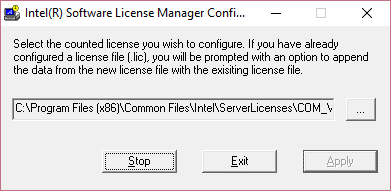
6.1.1.1 License file
6.1.1.2 Start
6.1.1.3 Stop
6.1.1.4 Apply
6.1.2 LMTOOLS.exe
6.1.2.1 Launch and Usage
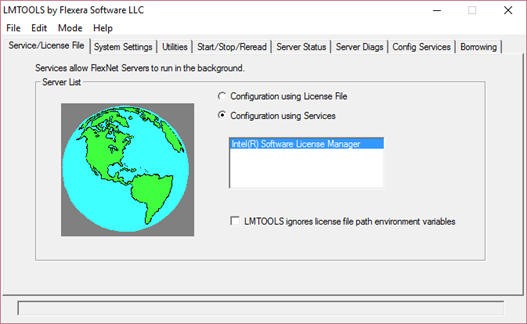
6.1.2.2 System Settings
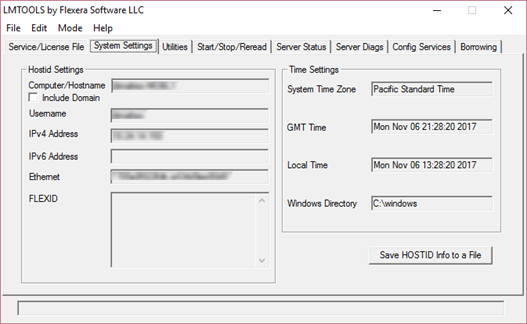
6.1.2.3 Start/Stop/Reread

6.1.2.4 Server Status/Server Diags
Server Status
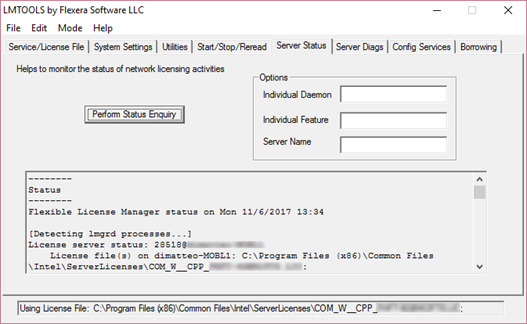
Server Diags
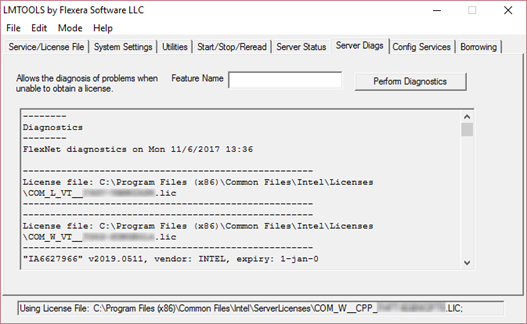
6.1.2.5 Config Services
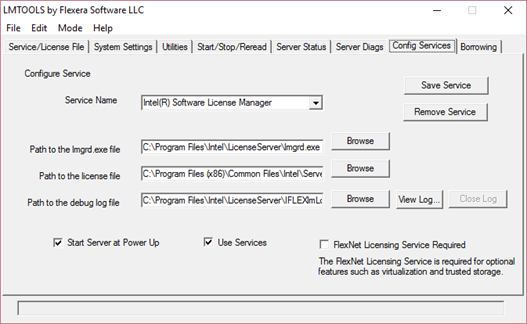
Path to lmgrd.exe file
Path to the license file
Path to the debug log file
Start Server at Power Up
Use Services
FlexNet Licensing Service Required
6.1.2.6 Borrowing

6.1.3 lmgrd.exe
- Open a Command Prompt as administrator
- Move to the license manager install directory
- Run lmgrd with options –c <license file> and –l <log file>
cd <install-directory> lmgrd –c <path to license file> -l <path to log file>
6.1.4 Lmutil.exe
6.2 Linux* Utilities
6.2.1 Start the license manager (lmgrd)
- The port used by lmgrd is defined in the top line, defaulted to 27009.
- The daemon to serve licenses for a particular vendor (INTEL) is defined in the second line. The port for the INTEL daemon may also be defined in this line, otherwise it will be assigned by the OS when lmgrd starts.
- Both ports used by lmgrd and the INTEL daemon must be open.
lmgrd –c <license file> -l <log file>
-2 -p
-x lmdown
-x lmremove
6.2.2 Check the license manager status (lmstat)
- lmgrd version, port number, and license file used
- INTEL daemon version
- Total number of license seats available for individual components listed in the license(s)
- Number of license seats currently in use for each component
lmstat –a
6.2.3 Check the host ID used by the license manager (lmhostid)
lmhostid
6.2.4 Reread the license file (lmreread)
lmreread –c <license file>
6.2.5 Release a license seat (lmremove)
Users of PerfAnl: (Total of 7 licenses issued; Total of 1 license in use) "PerfAnl" v2018.0914, vendor: INTEL, expiry: 1-jan-0 platforms: i86_n i86_r i86_re ia64_n amd64_re i86_mac x64_n x64_mac , vendor_string: SUPPORT=COM https://lemcenter.intel.com nodelocked license locked to NOTHING (hostid=ANY) user1 hostname1 /dev/pts/0 (v2007.0901) (serverhost/27009 203), start Mon 11/13 12:26
- Feature = PerfAnl
- User name = user1
- Host = hostname1
lmremove –c <license file> <feature> <user name> <host>
6.2.6 Shut down the license manager (lmdown)
lmdown –c <license file>
6.2.7 Remove the license manager (uninstall.sh)
- Run the uninstall.sh script to remove the installed files from the system.
- To permanently remove the Intel® Software License Manager, delete the lines that were added to the system startup files as described in section 4.2.3 of this guide.
7. Using the Client Application for the First Time
7.1 Installing the Client Application
7.1.1 Use the client license file
SERVER <server name> <hostid> <port> USE_SERVER
7.1.2 Use the INTEL_LICENSE_FILE environment variable
27009@host1:27009@host2:27009@host3
7.1.3 Use the server license file
7.2 License Check-out
7.2.1 License Seat Allocation Overview
7.2.2 Check License Allocation Status
Linux*
lmstat -a -c <license file>
Windows*
lmutil lmstat –a –c <license file>
Linux*
lmstat -a
Windows*
lmutil lmstat –a
7.2.3 License Borrowing
7.2.3.1 Borrow
- Copy the lmutil component to the client machine.
- Run lmutil lmborrow INTEL dd-mmm-yyyy [hh:mm]
- INTEL is the vendor daemon to borrow from
- The date is when the license will be returned, and must be less than the maximum borrow time specified in the license file.
- Run the application to check out and borrow the license.
- Verify that the license seat has been borrowed by running lmutil lmborrow –status
- Disconnect from the network to use the license without connecting to the license server.
7.2.3.2 Return
8. Troubleshooting
8.1 Getting Online Support
8.2 Creating Debug Logs for License Checkout Issues
8.2.1 License Server Log
- For Windows* this is typically located at C:\Program Files\Intel\licenseserver\Iflexlm.log
- For Linux* and Mac OS*, this is typically located at /opt/intel/licenseserver/lmgrd.log
8.2.2 Client Log
- Set INTEL_LMD_DEBUG. If it is already set, please clear the log file it points to.
- Run the application with the license failure.
- Send the log file to support.
8.2.3 lmstat Output
8.3 Server Issues
8.3.1 License manager is not running
8.3.2 License manager is not serving licenses
8.3.2.1 Port Issues
8.3.2.2 License File Issues
- The license file is outdated. If the license has been renewed but the license file has not been updated on the server, then it may fail to serve seats for newer product versions, while able to serve older product checkouts.
- The license version is outdated. Licenses are upgraded as newer products change the feature codes they use. Even though a license for the 2015 product version is valid and current, it may not contain the right codes for newer product checkouts. Upgraded licenses will always be backward compatible for older products.
- Multiple license files are used inefficiently. The Intel® Software License Manager can serve licenses from a variety of license files and versions. However, it may not serve those licenses in the most efficient order. An example is if you have a license for two Composer Edition 2015 seats and one for two Composer Edition 2017 seats, for a total of four. If requests for the 2015 version consume the 2017 seats, then requests for the 2017 version will have to wait. That means two seats are being consumed out of a total of four. To enforce the order of licenses used, combine the license files.
8.3.3 Verify Compatible Versions
8.4 Client Issues
8.4.1 Slow Checkouts
- Old license server information or license files. Check the following places for invalid licenses and delete any found:
- INTEL_LICENSE_FILE environment variable - make sure port@host is correct and any folders specified do not contain invalid license files.
- For Linux: /opt/intel/licenses
- For Windows: [Program Files]\Common Files\Intel\Licenses
- Slow DNS lookups. Newer versions of the product always do DNS resolution before connecting to the license server, even with IP addresses. Make sure that the fastest nameserver is called first, by checking nsswitch.conf and resolv.conf, for example.
- INTEL_LMD_DEBUG is set. If you are not actively debugging license checkouts, make sure this environment variable is not set.
8.4.2 No Checkouts
8.5 Information Needed for Support Requests
- Client Information
- Intel Software License Manager Information
8.5.1 Client Information
- Package ID of the product. This is the name of the file you downloaded and installed.
- Name of client application with all parameters.
- Operating system, architecture, kernel, glibc, and any service packs installed on the client system.
- Values to which the LM_LICENSE_FILE and INTEL_LICENSE_FILE environment variables are set.
- A copy of all license files used on the client system. It is important to copy the license files themselves rather than copy/pasting the contents as this can mask other potential problems with the files.
- On Linux* or OS X*, set INTEL_LMD_DEBUG to /tmp/licensecheckout.log and on Windows*, set INTEL_LMD_DEBUG to C:\temp\licensecheckout.log and run the client. Once the client finishes execution, attach the licensecheckout.log to the support issue.
- If you are opening a support request about a segmentation fault issue, attach the stack dump.
8.5.2 Intel Software License Manager Information
- The output of lmstat –a (Linux*) or lmutil lmstat –a (Windows*)
- Operating system, architecture, kernel, glibc, and any service packs installed on the system on which the Intel® Software License Manager server is installed.
- The Intel® Software License Manager server file name that you downloaded and installed
- A copy of the server log file at one of the following locations, depending on your operating system:
- Windows*: <install drive>:\program files\common files\intel\flexlm\iflexlm.log
- Linux*: <install location of servers>/lmgrd.log
- A copy of the license file you used to start the server. It is important to copy the license files themselves rather than copy/pasting the contents as this can mask other potential problems with the files.
- Values to which the LM_LICENSE_FILE and INTEL_LICENSE_FILE environment variables are set.